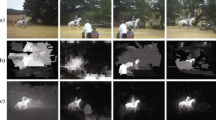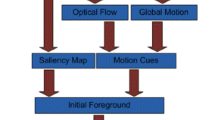Abstract
Salient object segmentation in videos is generally broken up in a video segmentation part and a saliency assignment part. Recently, object proposals, which are used to segment the image, have had significant impact on many computer vision applications, including image segmentation, object detection, and recently saliency detection in still images. However, their usage has not yet been evaluated for salient object segmentation in videos. Therefore, in this paper, we investigate the application of object proposals to salient object segmentation in videos. In addition, we propose a new motion feature derived from the optical flow structure tensor for video saliency detection. Experiments on two standard benchmark datasets for video saliency show that the proposed motion feature improves saliency estimation results, and that object proposals are an efficient method for salient object segmentation. Results on the challenging SegTrack v2 and Fukuchi benchmark data sets show that we significantly outperform the state-of-the-art.







Similar content being viewed by others
Notes
Note that you cannot know with certainty which of the λ’s is related to the object and which to the background, but you do know that a high λ2 indicates the presence of two local motion vectors.
References
Achanta R, Hemami S, Estrada F, Susstrunk S (2009) Frequency-tuned salient region detection. In: IEEE Conference on Computer Vision and Pattern Recognition, pp 1597–1604
Azaza A, Van de Weijer J, Douik A, Masana M (2018) Context proposals for saliency detection. Comput Vis Image Underst 174:1–11
Bigun J, Granlund GH, Wiklund J (1991) Multidimensional orientation estimation with applications to texture analysis and optical flow. IEEE Trans Pattern Anal Mach Intell 13(8):775–790
Borji A, Cheng M-M, Jiang H, Li J (2014) Salient object detection:, A survey, arXiv preprint arXiv., pp 1411–5878
Borji A, Cheng M-M, Jiang H, Li J (2015) Salient object detection: A benchmark. IEEE Trans Image Process, pp 5706–5722
Breiman L (2001) Random forests. Machine learning, pp 5–32
Brox T, Malik J (2010) Object segmentation by long term analysis of point trajectories. European Conference on Computer Vision, pp 282–295
Bruce N, Tsotsos J (2010) Saliency based on information maximization. In: Advances in Neural Information Processing Systems, pp 282–295
Carreira J, Sminchisescu C (2010) Constrained parametric min-cuts for automatic object segmentation. In: IEEE Conference on Computer Vision and Pattern Recognition, pp 3241–3248
Fragkiadaki K, Zhang G, Shi J (2012) Video segmentation by tracing discontinuities in a trajectory embedding. In: IEEE Conference on Computer Vision and Pattern Recognition, pp 1846–1853
Frintrop S, Werner T, García GM (2015) Traditional saliency reloaded: a good old model in new shape. In: IEEE Conference on Computer Vision and Pattern Recognition, pp 82–90
Fukuchi K, Miyazato K, Kimura A, Takagi S, Yamato J (2009) Saliency-based video segmentation with graph cuts and sequentially updated priors. In: IEEE International Conference on Multimedia and Expo, pp 638–641
Goferman S, Zelnik-Manor L, Tal A (2012) Context-aware saliency detection. IEEE Trans Pattern Anal Mach Intell 34(10):1915–1926
Itti L, Koch C, Niebur E, et al. (1998) A model of saliency-based visual attention for rapid scene analysis. IEEE Trans Pattern Anal Mach Intell 20(11):1254–1259
Kim H, Kim Y, Sim J-Y, Kim C-S (2015) Spatiotemporal saliency detection for video sequences based on random walk with restart. IEEE Trans Image Process 24 (8):2552–2564
Harel J, Koch C, Perona PO (2006) Graph-based visual saliency. In: Advances in Neural Information Processing Systems, pp 545–5524
Han B, Li X, Gao X, Tao D (2012) A biological inspired features based saliency map. In: International Conference on Computing, Networking and Communications, pp 371–375
Itti L, Baldi P (2005) A Principled approach to detecting surprising events in video. In: IEEE Computer Society Conference on Computer Vision and Pattern Recognition, pp 631–637
Jiang H, Wang J, Yuan Z, Wu Y, Zheng N, Li S (2013) Salient object detection: A discriminative regional feature integration approach. in: Proceedings of the IEEE Conference on Computer Vision and Pattern Recognition, pp 2083–2090
Jiang H, Wang J, Yuan Z, Liu T, Zheng N, Li S (2011) Automatic salient object segmentation based on context and shape prior. In: British Machine Vision Conference, pp 2083–2090
Judd T, Ehinger K, Durand F, Torralba A (2009) Learning to predict where humans look. in: IEEE 12th International Conference on Computer Vision, pp 2106–2113
Kim J, Han D, Tai Y-W, Kim J (2014) Salient region detection via high-dimensional color transform. In: Proc IEEE Conf Comput Vis Pattern Recognit, pp 883–890
Krähenbühl P, Koltun V (2014) Geodesic object proposals. European Conference on Computer Vision, pp 725–739
Li F, Kim T, Humayun A, Tsai D, Rehg JM (2013) Video segmentation by tracking many figure-ground segments. In: Proceedings of the IEEE International Conference on Computer Vision, pp 2192–2199
Liu Z, Zhang X, Luo S, Le Meur O (2014) Superpixel-based spatiotemporal saliency detections. IEEE Trans Circuits Syst Video Technol 24(9):1522–1540
Lin X, Casas JR, Pardas M (2017) 3D point cloud segmentation using a fully connected conditional random field. In: 25th European Signal Processing Conference (EUSIPCO), pp 66–70
Lee YJ, Kim J, Grauman K (2011) Key-segments for video object segmentation. In: International Conference on Computer Vision, pp 1995–2002
Lezama Jo, Alahari K, Sivic J, Laptev I (2011) Track to the future: Spatio-temporal video segmentation with long-range motion cues. In: IEEE Conference on Computer Vision and Pattern Recognition (CVPR), pp 3369–3376
Li Y, Hou X, Koch C, Rehg JM, Yuille Al (2014) The secrets of salient object segmentation. IEEE Conference on Computer Vision and Pattern Recognition, pp 280–287
Lucas BD, Kanade T, et al. (1981) An iterative image registration technique with an application to stereo vision. In: International Joint Conference on Artificial Intelligence, pp 674–679
Mancas M, Riche N, Leroy J, Gosselin B (2011) Abnormal motion selection in crowds using bottom-up saliency. In: IEEE International Conference on Image Processing, pp 229–232
Ma T, Latecki LJ (2012) Maximum weight cliques with mutex constraints for video object segmentation. In: IEEE Conference on Computer Vision and Pattern Recognition, pp 670–677
Marat S, Phuoc TH, Granjon L, Guyader N, Pellerin D, Guérin-Dugué A (2009) Modelling spatio-temporal saliency to predict gaze direction for short videos. In: International journal of computer vision, vol 82,3, Springer, p 213
Mauthner T, Possegger HD, Waltner G, Bischof H (2015) Encoding based saliency detection for videos and images. In: Proceedings of the IEEE Conference on Computer Vision and Pattern Recognition, pp 2494–2502
Nah S, Lee KM (2015) Random forest with data ensemble for saliency detection. In: Asia-Pacific Signal and Information Processing Association Annual Summit and Conference, pp 604–607
Oneata D, Revaud J, Verbeek J, Schmid C (2014) Spatio-temporal object detection proposals. In: European Conference on Computer Vision, pp 737–752
Papazoglou A, Ferrari V (2013) Fast object segmentation in unconstrained video. In: Proceedings of the IEEE International Conference on Computer Vision, pp 1777–1784
Rahman A, Houzet D, Pellerin D, Marat S, Guyader N (2011) Parallel implementation of a spatio-temporal visual saliency model. J Real-Time Image Proc 6 (1):3–14
Rahtu E, Kannala J, Salo M, Heikkilä JE (2010) Segmenting salient objects from images and videos. In: European Conference on Computer Vision, pp 366–379
Simoncelli EP, Adelson EH, Heeger DJ (1991) Probability distributions of optical flow. In: Computer Society Conference on Computer Vision and Pattern Recognition, pp 310–315
Singh A, Chu C-HH, Pratt M (2015) Learning to predict video saliency using temporal superpixels. In: International Conference on Pattern Recognition Applications and Methods, pp 201–209
Uijlings JRR, van de Sande KEA, Gevers T, Smeulders AWM (2013) Selective search for object recognition. Int J Comput Vis 104(2):154–171
Van De Weijer J, Gevers T, Smeulders AWM (2006) Robust Photometric invariant features from the color tensor. IEEE Trans Image Process 15(1):118–127
Wang J, Tavakoli H, Laaksonen J (2017) Fixation prediction in videos using unsupervised hierarchical features. In: Proceedings of the IEEE Conference on Computer Vision and Pattern Recognition Workshops, pp 50–57
Wang X, Ma H, Chen X (2016) Geodesic weighted Bayesian model for saliency optimization. Pattern Recogn Lett 75:1–8
Wang W, Shen J, Porikli F (2015) Saliency-aware geodesic video object segmentation. In: Proc IEEE Conf Comput Vis Pattern Recognit, pp 3395–3402
Wang L, Lu H, Ruan Xg, Yang M (2015) Deep networks for saliency detection via local estimation and global search. In: IEEE Conference on Computer Vision and Pattern Recognition, pp 3183–3192
Wang P, Wang J, Zeng G, Feng J, Zha H, Li S (2012) Salient object detection for searched web images via global saliency. In: IEEE Conference on Computer Vision and Pattern Recognition, pp 3194–3201
Yang C, Zhang L, Lu H, Ruan X, Yang M-H (2013) Saliency detection via graph-based manifold ranking. In: Proceedings of the IEEE Conference on Computer Vision and Pattern Recognition, pp 3166–3173
Zhang D, Javed O, Shah M (2013) Video object segmentation through spatially accurate and temporally dense extraction of primary object regions. In: Proceedings of the IEEE Conference on Computer Vision and Pattern Recognition, pp 628–635
Zhong S-h, Liu Y, Ren F, Zhang J, Ren T (2013) Video Saliency detection via dynamic consistent Spatio-Temporal attention modelling. In: National Conference of the American Association for Artificial Intelligence, pp 1063–1069
Author information
Authors and Affiliations
Corresponding author
Ethics declarations
Conflict of interests
Author Rahma Kalboussi declares that she has no conflict of interest. Aymen Azaza has conflict of interest with the Universidad Autonoma de Barcelona where he is a current PhD student (email extension uab.es). Joost van de Weijer has conflict of interest with the Universidad Autonoma de Barcelona where he works (email extension uab.es). Mehrez Abdellaoui and Ali Douik and has conflict of interest with the University of sousse where they work.
Additional information
Human and Animal Rights and Informed Consent
During this project, research has involved no Human Participants and/or Animals. Informed consent was obtained from all individual participants included in this project.
Publisher’s note
Springer Nature remains neutral with regard to jurisdictional claims in published maps and institutional affiliations.
Rights and permissions
About this article
Cite this article
Kalboussi, R., Azaza, A., van de Weijer, J. et al. Object proposals for salient object segmentation in videos. Multimed Tools Appl 79, 8677–8693 (2020). https://doi.org/10.1007/s11042-019-07781-0
Received:
Revised:
Accepted:
Published:
Issue Date:
DOI: https://doi.org/10.1007/s11042-019-07781-0




